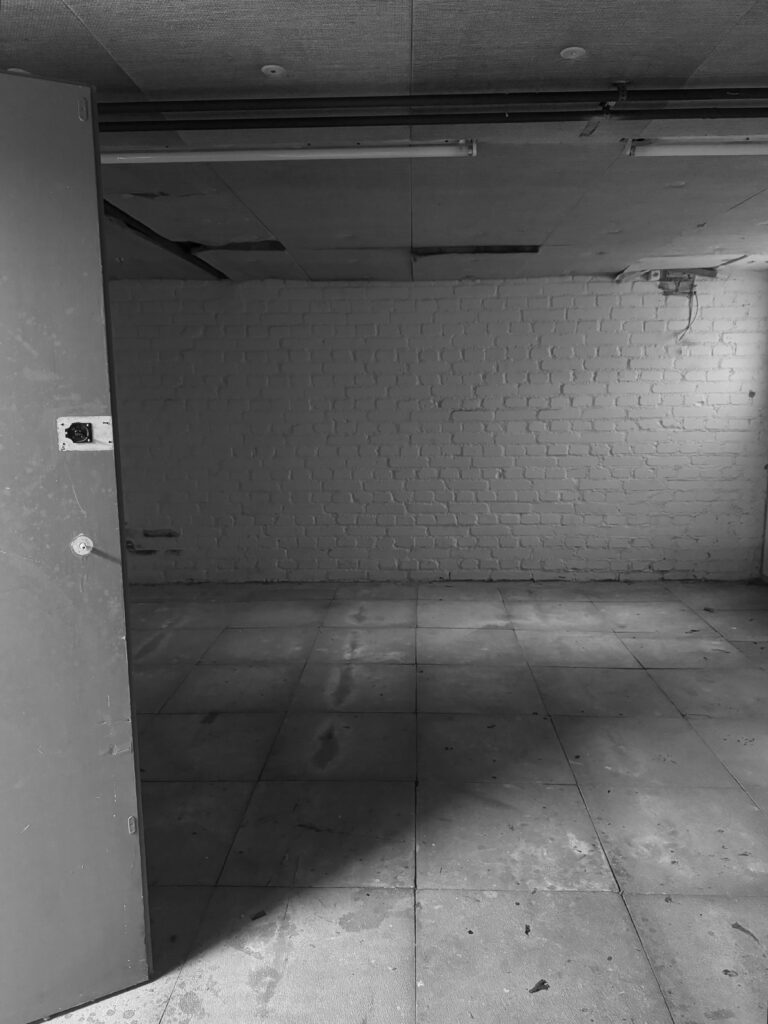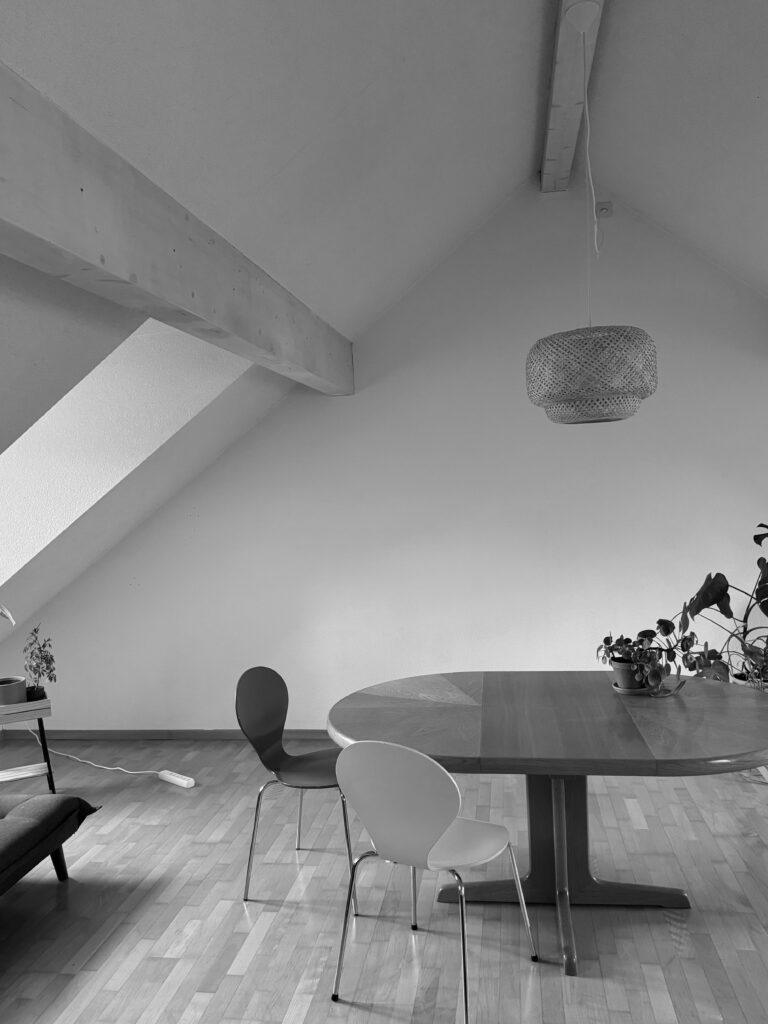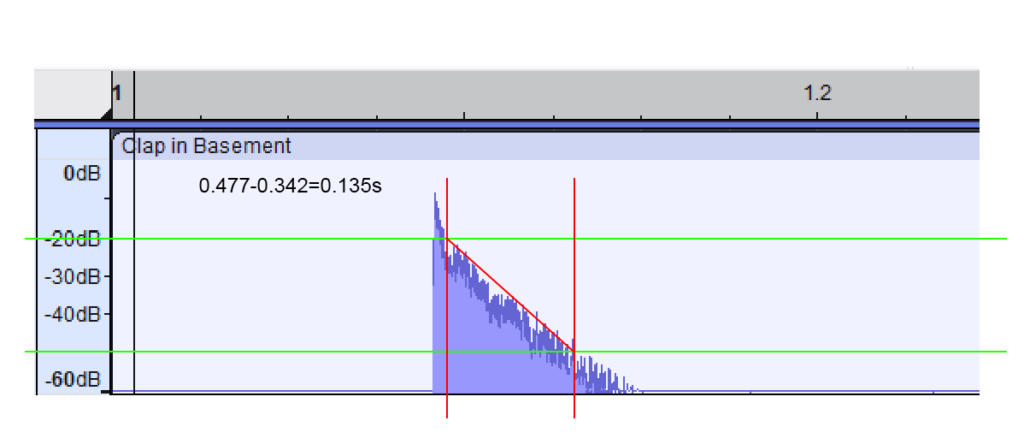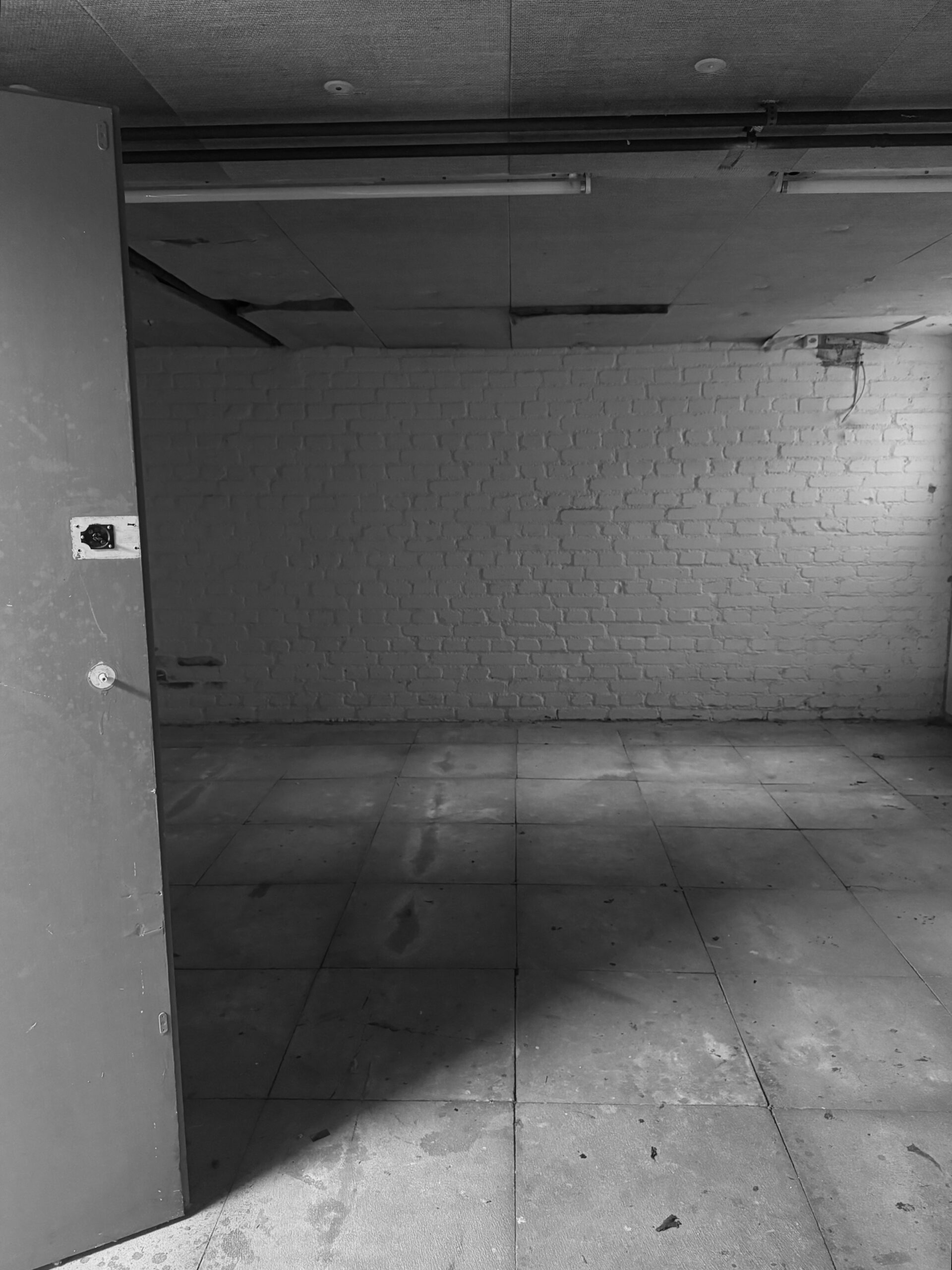
My Basement
The main purpose of my basement is for laundry. There is also some space for storage, but since it’s mostly unused at the moment, the room remains quite empty.
What makes the space noteworthy in terms of acoustics is the strong sound insulation. This becomes especially noticeable when you enter the room, as the sound seems to stay close to you when you speak. Even though the room is empty and built with hard materials on the walls and floor. In acoustic terms, this is often referred to as a “dead” and ” Sterile” room.
In the recording, I can hear differences in how close I am to the microphone based on the volume of the sound. The “dead” nature of the room makes this more pronounced.

Living Room
The main purpose of my living room is for social gatherings with friends, where more people tend to gather.
The space is noteworthy in terms of acoustics due to how sounds reflect, making the room acoustically loud. Even small sounds, like footsteps, become amplified, and you notice the reflective acoustics as soon as you enter the room. The way sound behaves in the space gives the impression of a larger room. In acoustic terms, the space would be described as open with a bit of reverb.
In the recording, I can hear sound very clearly when I’m close to the microphone and near a wall, which shortens the reflections. Moving away from the microphone, deeper into the room, allows the sound to reflect more, especially since the room is large and mostly empty. The primary sound dampening comes from the furniture; otherwise, the room’s hard, flat surfaces, such as the ceiling and floor, contribute to its reflective nature.
2 Exploring the Emotional Impact of Everyday Sounds

The two situations I have chosen from my daily life are: one from the school building where I attend a course, and the second from a nearby forest where I usually go for my runs.
In the school building, the room is located in a large concrete hall where many students work with tools, and there are frequent discussions between students and teachers as well as among the students themselves. The sound in the room is highly reflective, so the most emergent sound are the echoes and the sounds created by materials colliding. The echoes are also the most noticeable sounds in the space.
The most overheard sounds are the sharp, high-pitched noises that occur when someone drops metal or other hard materials on the concrete floor. The overall noise in the room makes my emotional state and perception of the situation uncomfortable, due to the loud environment with many different sounds that escalate because of the echoes caused by the room’s reflective surfaces. The high-pitched noise from materials hitting or dropping is the most uncomfortable and also the loudest sound in the room.
The sound that would most alert me would be a very loud, high-pitched noise that repeats frequently.
In the forest where I usually go for my runs, it is a very calm space with little activity and usually no other people. The forest is located in the city of Zurich, so the emergent sound is the low-frequency hum from traffic surrounding the area. The catchy sounds are from the birds whistling. The most likely overheard sounds in this place would probably be high-pitched noises, as they stand out against the constant low-pitched hum of the traffic.
The overall soundscape of this place makes me feel calm. The distant traffic noise helps me feel connected to the surroundings, but because it is so consistent, you gradually stop noticing it. The sounds of birds and the general quietness of the forest further contribute to my peaceful emotional state and perception of the environment.
The sounds that would cause discomfort would be unexpected noises coming from nearby. Since there are rarely other people around, such unexpected sounds would stand out. While they may not necessarily cause discomfort, they would be very noticeable and would likely alert me, as they break the quietness of the space.
3 Empirical and numerical estimation of room acoustic properties
For this task, I revisited my living room and basment. In the recording below you can hear the claps in those spaces.
Living room

From the graph, I get that the RT30 has a reverberation time of 0.42sec, and RT60 has a reverberation time of 0.84sec.
Basment

From the graph, I get that the RT30 has a reverberation time of 0.14sec, and RT60 has a reverberation time of 0.28sec.
4 Characterization of room acoustic treatments
I’ve been focusing on three indoor spaces throughout this core project: my basement and living room at home, and a classroom in the school building where I attend design classes.
The Basement: This space is a square with four straight walls made of painted brick and a concrete floor—both materials are sound-reflective surfaces. The ceiling is covered with mineral wool insulation, concealed by a fabric layer. This material is exposed across the entire ceiling, absorbing sound effectively, especially in the high-frequency range.
Despite the abundance of hard materials on the walls and floor, this space feels non-reflective acoustically. The low ceiling and effective sound-absorbing material on the ceiling are key factors in achieving this. The lower ceiling height reduces the room’s volume, which in turn shortens the distance sound waves can travel between reflective surfaces. Additionally, the proximity of the ceiling to your head enhances the absorption of sound.
Since the ceiling already has comprehensive sound absorption, any furniture in this space could feature large, flat surfaces to introduce more reflection. Adding more absorbent furniture isn’t necessary from an acoustic standpoint.
From a visual perspective, the sound absorber on the ceiling integrates discreetly with the space’s design.
The Living room:
The living room is in an attic, so the walls slope inward at an angle over the room. The materials used include a wood parquet floor and plaster walls. There are large surfaces in the room without any sound absorption, and the space is quite open and relatively spacious, which causes the sound to reflect more easily.
When you clap in the room, you can clearly hear the sound reflecting multiple times, bouncing back and forth. Due to the larger volume of the space, sound waves travel further before dissipating, and the hard surfaces in the room create early reflections. This combination results in a noticeable echo effect in space, adding a sense of reverberation.
Due to the lack of sound absorption in the room, especially in the high-frequency range, adding large, soft furniture and a carpet could help absorb sound. Currently, the room is quite empty, with very few furnishings.
5 The full picture

School Building Acoustic Design
The primary function of this space is to serve architecture students by providing an environment for project work, including office tasks, practical model workshops, reviews, and lectures.
Specifications, standards, guidelines for school evierment:
European Union
- Building Bulletin 93 (BB93) – Acoustic Design of Schools: Performance Standards (UK)
o Sets out detailed acoustic criteria for classrooms, music rooms, gymnasiums, and auditoriums.
o Background noise: ≤30-35 dBA.
o Speech intelligibility requirements using STI (Speech Transmission Index): ≥0.6-0.75. - EN 12354-1 to 6 – Building Acoustics: Estimation of Acoustic Performance of Buildings
o Addresses sound insulation, reverberation, and noise control in buildings, including schools. - DIN 18041 (Germany) – Audibility in Rooms: Acoustic Quality in Educational Facilities
o Provides guidelines for optimizing reverberation time and speech intelligibility.
General Guidelines - WHO Guidelines for Classroom Acoustics
o Recommended levels for background noise and reverberation to support learning. - Acoustical Society of America (ASA) Guidelines
o Provides best practices for designing acoustically suitable educational spaces. - Council of Educational Facility Planners International (CEFPI)
o Guidelines for integrating acoustics in modern school designs.
Key Parameters Across Standards
| Parameter | Typical Specification |
| Background Noise Level | ≤35 dBA in classrooms, ≤30 dBA in libraries |
| Reverberation Time (RT) | ≤0.6 seconds (standard classrooms) |
| Sound Transmission (STC) | STC 50+ for walls between classrooms |
| HVAC Noise Level | ≤NC-25 or RC-25 |
| Speech Transmission Index | ≥0.75 (good speech intelligibility) |
Current Acoustic Situation
Acoustically Effective Elements
• The room currently lacks dedicated acoustic absorbers.
• Walls and ceilings are constructed from concrete, which predominantly reflects sound rather than absorbing it.
• Absorption is minimally achieved by occupants and irregularly shaped furnishings.
• Most furniture is made of hard materials, which primarily reflect sound, dispersing it rather than absorbing it.
Room Geometry
• The room is a large, square volume with parallel walls and a flat ceiling.
• These characteristics amplify sound reflection and may cause reverberation and echo.
• The overall material palette (concrete) contributes to a highly reflective environment, leading to poor sound absorption.
Proposed Acoustic Measures
- Install Sound Absorbers
o Add acoustic panels to the walls to reduce the reflection of sound between parallel surfaces.
o Panels should target areas where sound reflection is most prominent, such as mid-wall height where most conversational noise occurs. - Ceiling Treatment
o Incorporate acoustic absorbers on the ceiling to mitigate vertical sound reflection.
o Ceiling panels can help control overall reverberation in the space, especially in open environments. - Space Division
o Use curtains or acoustic partitions to divide the room into zones for different activities, such as workshops and lectures.
o Dividing the space reduces sound overlap between simultaneous activities, enhancing focus and reducing noise levels.
Conclusion
By implementing these measures, the acoustic environment can be significantly improved to support the diverse activities of architecture students. Strategic placement of absorbers, and room zoning will create a balanced and functional space for both collaborative and individual tasks.
Final assignment
Project Overview
This project focuses on analyzing and optimizing the reverberation time (RT) in my living room to achieve better acoustic comfort. Currently, the sound in the space feels hollow, and excessive sound reflections are noticeable, which negatively impacts the overall auditory experience.
Current Acoustic State:
- Measured Reverberation Time: 0.84 seconds
- Ideal Reverberation Time: For living rooms, the optimal RT typically ranges from 0.4 to 0.6 seconds. For activities such as conversations or watching TV, a target RT of 0.4–0.5 seconds is ideal.
Project Goals The primary aim of this project is to reduce the reverberation time in the living room to approximately 0.5 seconds, ensuring it meets the standards for a comfortable and functional living space. This improvement will enhance the quality of activities such as conversations and watching TV for example.


From the graph, I get that the RT30 has a reverberation time of 0.42sec, and RT60 has a reverberation time of 0.84sec.
Results
By implementing the following changes:
– Adding a large carpet to absorb reflected sound from the angled ceiling.
– Installing a bookshelf to reduce sound reflections between the parallel walls.
– Introducing an additional couch to further reduce sound reflections between the parallel walls.
– Mounting an acoustic panel to minimize sound reflections between the parallel walls.
The reverberation time was successfully reduced to approximately 0.5 seconds.



